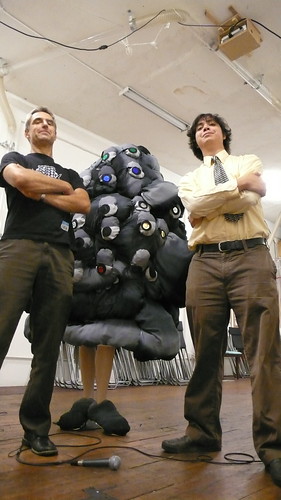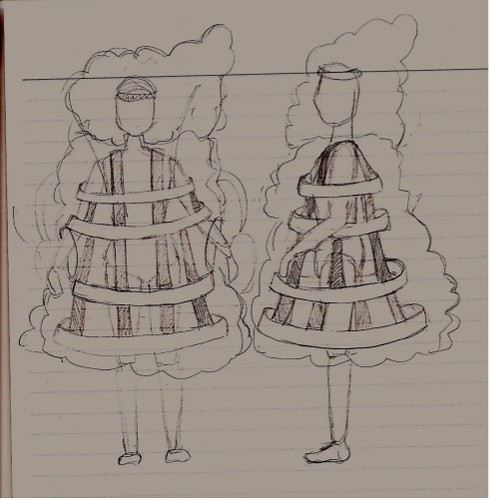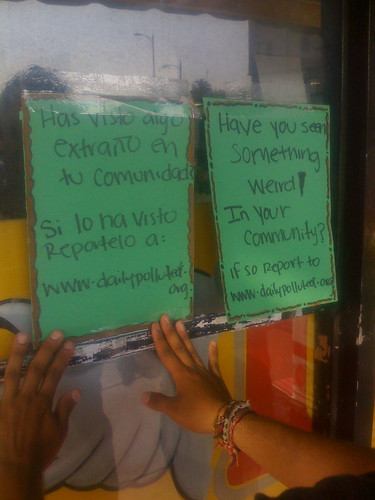I think these will trickle in every now and then. I’ll update this page as they do. (This is more for my reference than for selfish promotion.)
Category Archives: Black Cloud
This is how we do

An Open Letter of Invitation
Last night I sent out an email to a handful of random folk clogging my address book. In case you feel left out, I’ll post the (now open) letter here for any schmuck that doesn’t have plans for Saturday.
“We finally really did it!! You maniacs!”: An Invitation, A Warning!
Dear friends, colleagues, and other people of ill-reputable nature,
I don’t have much time to write this, but need to make sure the general public is informed.
Since July, my class of seniors at Manual Arts High School has been recruited to help investigate a mysterious black cloud hovering over Los Angeles. Using cutting edge technology, and with the assistance of representatives from UC Berkeley, Xylon Corporation, and First Breath Organization, my students have come ever closer to discovering the true nature of this black cloud of pollution: our pollution has developed its own consciousness and has been establishing contact with my students!
I don’t know if the cloud is aware that I’m sending this or even if such efforts will be thwarted. I need to warn all of you and also invite you to an unveiling of the students’ investigations. This Saturday, from 8-10 p.m., my students will be discussing their research and ecotopian visions of the future at Machine Project, 1200 D. North Alvarado, Los Angeles (next to Downbeat Café). There will be students, music, dancing, black cloud ice cream, lectures, tamales, interviews, and black cloud horchata.
The Black Cloud has started to infect my mind. I don’t know how much time is left until I fall into full, cloudy madness. Please come out on Saturday and join me in celebrating the Cloud (aka Cloudy McPufferson). Perhaps it can be persuaded to move elsewhere in the world. We created this beast, perhaps we can make it go away.
Sunny day,
Sweeping the Clouds Away,
On my way to where the air is sweet,
Can you tell me how to get,
How to get to North Alvarado and Sunset Blvd?
Antero Garcia
P.S. if you need more information about the black cloud, one of the gentlemen working with my class has posted a revealing expose.
Let the Truth Be Known!
Find A Pattern Towards Da Future
This may be the only other Twitter update that blows me away.
Class Twitter experiment is finally getting rolling. I’ll talk about the initial challenges, current use of the site, and post-BC plans for incorporating Twitter in due time.
(And if you’re on Twitter and basically followed all of the people “garcia_period1” is following, it would give you some context about the two above tweets. Otherwise you’ll have to wait for the game wrap up to come in August.)
Hey! Over Here … in the Real World!
C’mon people. I’m in South Los Angeles here. Our school’s Internet moves at just less than a creep. I can’t get a working ethernet cord, log on to social networking sites, youtube, etc. You’ve heard me whine about it before. Obviously most of my students aren’t accessing the Internet at home. Our isle of misfit computers at school is their only (semi-)reliable resource for developing media literacy skills. I don’t say this to bash the equipment at our school, but to criticize the disparity between my students’ opportunities to engage online and students in more affluent neighborhoods.
I continue to hear about amazing things happening in Second Life, about online study groups, and vodcasted lectures. But we’re still stuck in our first, perpetually offline life, like it’s still 1999 and Napster is alive and destroying our dial up connections.
At a recent school focus group meeting, several teachers discussed frustration with technology access on campus. The skills students need to succeed in college and beyond are expanding. Sooner or later someone is going to expect my students to be able to quickly and effortlessly post to a blog, add to a wiki, or collaborate via some sort of social networking protocol. And once again, my school will have failed to prepare them for such a task.
And About those Cameras
Somewhat related to this, I recently wrote about a video experiment I am conducting in my first period class. [If you’re too lazy to read the link, I’m having students in my first period class videotape the lesson everyday. Of course, I say it much more elegantly at the link, so just go over there ya putz!] What I’d like to add is that, by handing the cameras to the students, power and agency is shifted within the classroom. Suddenly, I’m not the one scoping out misbehavior; we are complicit in maintaining order within the classroom. As a result, the camera empowers instead of demeans – unlike the recently installed security cameras that students frequently bemoan.
On Friday, Professor Greg Niemeyer spoke with my students. Part of his talk described the differences between surveillance, co-veillance, and sousveillance. I have a feeling that this is something we will be revisiting on Monday.
What is Rhea Up To?
I found a secret sketch that Rhea left on the table. It looks like she’s up to something …

Maybe she is building protection from this.
Noticed Anything Strange?

More substantial posts coming this weekend. In the meantime, please report anything unusual to the Daily Polluter. Assistance for accessing the Black Cloud Monitoring Network coming soon.
First Breath.
Xylon.
(In Alphabetical Order.)
It’s time to take sides.
Some random updates
– The Beyond Pedagogy schedule has been updated here.
– I’ve been offering sample lessons from the Words on Walls graffiti unit I’ve been teaching over at the homeroom. It’s being updated once or twice a week at the moment. The description of the project is here.
– Innovation Division happenings: Manual Arts teachers will be voting on May 28th and 29th and Manual Arts parents will be voting on May 31st. All stops have been proverbially pulled out.
– Daye and I will be part of a demo/poster session at the HASTAC Conference on the 24th. We’ll be unveiling the revised Black Cloud game scheduled to launch in July. (I know the project isn’t listed on the site, but I assure I’ll be there!) Here are a few pictures of the student notebooks we’re developing for the game – check out the colored pupils on Cloudy! Daye’s a goku superstar and I’m the shoddy photographer here.



Full picture set here.
Kindergarten as a Secondary Practice
Before I get into the meat of this post, I wanted to mention that the schedule for the Beyond Pedagogy group has been revised – our last meeting was canceled at the 11th hour and will be rescheduled at our next meeting on May 8th. The full schedule is found here.
Now then, having recently finished the current reading selection, Inventing Kindergarten, I felt compelled to add to the list of imaginary classes that should be instituted down the line: Kindergarten 101.
What is Kindergarten?
Though Friedrich Froebel’s original vision of kindergarten has become terribly diluted, the original vision was of “a radical and highly spiritual system of abstract-design activities intended to teach the recognition and appreciation of natural harmony” (page 12). Frankly, the spirituality aspect of Froebel’s kindergarten isn’t to be taken lightly, the entire curricula was designed around a sense of discovered unity throughout life.
Aside from spirituality, the goals of curriculum were about student play and abstraction. Through a serious of activities and “gifts,” students are urged to slowly move from explicit and real representations to abstract and varied methods of understanding, visualizing, and imagining. The process is entirely unlike the kinds of practices enforced in high schools today.
And while kindergarten kept kids busy every day (the class itself being rigorously structured), the entire process was to feel natural and fun: “Kindergarten was play, and a good kindergartener made certain her little sprouts never thought otherwise – the theoretical underpinnings of the education were kept from children just as they are in any classroom situation” (page 145). Not sure, I’d agree with the last clause – I’ve used Freire as a means to open discussion and dialogue in my class and candidly discuss motivations behind my practice. However, there are certain things that remain behind the curtain, as I’ll explain about the Black Cloud.
I realize this is a painfully limited description (go read the book!), I mainly want to outline the key goals of kindergarten: unity, natural harmony, abstraction, and play. As Brosterman explains, “The intended result of this all-encompassing instruction was the creation of a sensitive, inquisitive child with an uninhibited curiosity and genuine respect for nature, family, and society…” (page 39).
So What Went Wrong?
I mentioned that kindergarten ain’t as it used to be. The main reason for this – surprise – is crass consumerism. The “gifts” that are essential to the kindergarten experience became marketed so aggressively that production flaws would change or “enhance” the tools used in the class: “the gifts have been transformed, the educational objective for what is left of the occupations has been lost of corrupted” (page 40). Similarly, the teachers that continued the tradition of Froebel’s kindergarten didn’t have the kind of subtle and detailed training that was required. A certain amount of finesse was required for the differentiated and nuanced work that took place every day in the class.
Funnily enough, consumerism is part of what’s ruining education today as well! Public schools are being forced to “comply” with specific curriculum as is often created by private companies and organizations. There are ferocious bidding wars by groups like Prentice Hall and Holt to be the “official” textbook within a school. Millions of dollars are at stake. The material? About as good as a one-size-fits-all solution can be. At a recent professional development meeting, the presenter mentioned that most questions within English textbooks rarely invoke the higher order thinking skills in Bloom’s taxonomy. (Synthesize??? What’s that?!)
But Why in High School?
Today, students come into my class at the beginning of the year wary, uninterested, and expecting to do the work to pass the class. The curiosity factor is nil. The occasional expressive and interested student is seen as a thrilling anomaly and is quickly fetishized by a handful of teachers. Most are not the “sensitive, inquisitive” children of Froebel’s dreams. And if that sounds like a slight to the students I teach, it’s not: the things that my students write, create, or express continually amaze me throughout my class. However, somewhere along the line, students were programmed to stop asking questions, stop having fun, and start learning how to bubble in the “right” answers on by-rote exams on a semi-annual basis. Yes, schools really do kill creativity.
Students need to feel comfortable playing; this is part of the process of learning and being creative. We need a system for students to get back into the habit of having fun.
What Would This Look Like in High School?
A lot of this is about changing what happens inside the classroom. Why can’t there be a sense of mystery in an English class? Why can’t your history class be inquiry based and allow room for “play”?
What most excites me about the Black Cloud game is the opportunity to completely throw students off balance. Not only will students be playing a game for a month and a half in my class, but – for most of the time – they won’t even know they are playing a game. The entire project relies on student curiosity. Yes, we’re still learning the necessary English skills I’m required to teach, but we’re doing it in a way that Froebel would probably admire. (And just like in Kindergarten, the actual learning and “goals” of the unit remain hidden. The premise of play and discovery are all that is visible for the students).
Kindergarten is a pedagogical tool that can be adapted for all ages. It’s classroom interaction, student and teacher roles within the classroom, and school activities re-envisioned. It was invented more than 150 years ago and it just might be the most refreshing way to transform the current educational landscape.
EDIT: No, I don’t know why I wrote “Post-secondary” when I was talking about high school… it’s fixed now. It’s monday and it’s already been a long week…